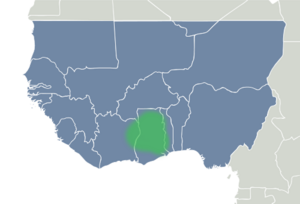
The Kintampo complex, also known as the Kintampo culture, Kintampo Neolithic, and Kintampo Tradition, was established by Saharan agropastoralists, who may have been Niger-Congo or Nilo-Saharan speakers and were distinct from the earlier residing Punpun foragers,[1] between 2500 BCE and 1400 BCE.[2] The Kintampo complex was a part of a transitory period in the prehistory of West Africa, from pastoralism to sedentism in West Africa, specifically in the Bono East region of Ghana,[3][1] eastern Ivory Coast, and Togo.[1] The Kintampo complex also featured art, personal adornment items, polished stone beads, bracelets, and figurines; additionally, stone tools (e.g., hand axes) and structures (e.g., building foundations) were found, which suggests that Kintampo people had both a complex society and were skilled with Later Stone Age technologies.[4]
- ^ a b c Cite error: The named reference
Watsonwas invoked but never defined (see the help page). - ^ Ness, Immanuel (Nov 10, 2014). "Sub-Saharan Africa: Archaeology". The Global Prehistory of Human Migration. Wiley Blackwell. p. 110. ISBN 9781118970591. OCLC 890071926. S2CID 160957067.
- ^ Casey, Joanna (2000). The Kintampo Complex: The Late Holocene on the Gambaga Escarpment, Northern Ghana. Archaeopress. ISBN 978-1-84171-202-4.
- ^ Anquandah, James (1995) The Kintampo Complex: a case study of early sedentism and food production in sub-Sahelian west Africa, pp. 255–259 in Shaw, Thurstan, Andah, Bassey W and Sinclair, Paul (1995). The Archaeology of Africa: Food, Metals and Towns. London: Routledge. ISBN 0-415-11585-X